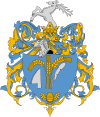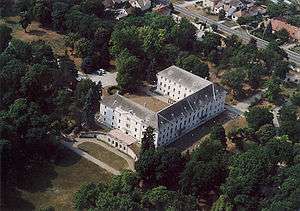Bicske
Bicske [ˈbitʃkɛ] is a town in Fejér county, Hungary. Its name is also spelled Bykche, Biccke, Bykcze, Biczke, and Bitske. It is around 35 km (22 mi) west of Budapest. Its administration has undergone many changes; it has been a settlement, a village, a market town, and a village constituting an administrative division.
Bicske Lusomana / Lumanum (in Latin) | |
|---|---|
 | |
 Flag  Coat of arms | |
 Bicske Location of Bicske | |
| Coordinates: 47.49074°N 18.63625°E | |
| Country | |
| County | Fejér |
| District | Bicske |
| Area | |
| • Total | 78.88 km2 (30.46 sq mi) |
| Population (2017) | |
| • Total | 12,100[1] |
| Time zone | UTC+1 (CET) |
| • Summer (DST) | UTC+2 (CEST) |
| Postal code | 2060 |
| Area code | (+36) 22 |
| Motorways | M1 |
| Distance from Budapest | 36.7 km (22.8 mi) East |
| Website | www |
History
The name of the Byckche family has been known since 1258 when some members got a large donation of land from the king. According to a document dating from 1306, Botond's sons János (John) and Péter were granted permission to levy tolls in the locality of Bicske.

From 1596 onward, Bicske belonged to the Ottoman Empire.
Count Ádám Batthyány bought the land in 1642. The Batthyány family built a castle in 1754–1755, and made it their residence. The Batthyány family also built an observatory and a little castle (Hegyi-kastély) for the astronomers. During the Batthyány era, the village, which had been destroyed by the Turks, became a prosperous town. From 1688 to 1877, it was the chief town of the district.
A Jewish community developed in Bickse during the 18th century; most of its members were associated with the Neolog or Reform Judaism movement. They built a synagogue and a school, which was open to both Christian and Jewish students.[2] By the 19th century Bicske was a well-developed market town and cultural centre. From 1877 to 1946 it belonged to the district of Vál.
After World War I, an era known as "The White Terror," lasting from 1919 - 1921, saw the Jewish community of Bikse under attack by Christians, as homes were looted and citizens were murdered.[2]
In 1940, during World War II, Jewish farms and shops were confiscated and nationalized and able-bodied Jewish men were sent to the Ukraine to work in the mines. In May 1940, a ghetto was erected in Bickse and Jews from neighboring towns were brought there for confinement. In June 1940, the ghetto was liquidated and its entire Jewish population was sent to the Komarom ghetto and, that same month, to Auschwitz concentration camp for extermination. The town's synagogue was completely destroyed.[2]
Bicske was captured on 24 December 1944 by Soviet troops of the 3rd Ukrainian Front in the course of the Budapest Offensive. On the night of 4 January 1945 the German Nazi 5th SS Panzer Regiment, under the command of Fritz Darges, advanced towards Bicske but was stopped by the 41st Guards Rifle Division of the Soviet 4th Guards Army. The Germans retreated, but destroyed more than thirty Soviet tanks during the battle.[3]
In 1947 Bickse became independent.
There were 12,000 inhabitants in 1986.
Main sights
- Roman Catholic Church (18th century) with a Maulbertsch panel painting
- Batthyany Castle (built in 1754-1755)
- In the center of the town are excavated ruins of a temple with several tombs, dating from the 15th century
- Ruins of the Observatory and the astronomers' castle
Twin towns — sister cities
Bicske is twinned with:



References
- Bicske, KSH
- https://dbs.bh.org.il/place/bicske Beit Hatfutsot Jewish Genealogy Databases
- Mitcham, Samuel W (2007). The German Defeat in the East, 1944–45. Mechanicsburg, PA: Stackpole Books. ISBN 978-0-8117-3371-7.CS1 maint: ref=harv (link)

